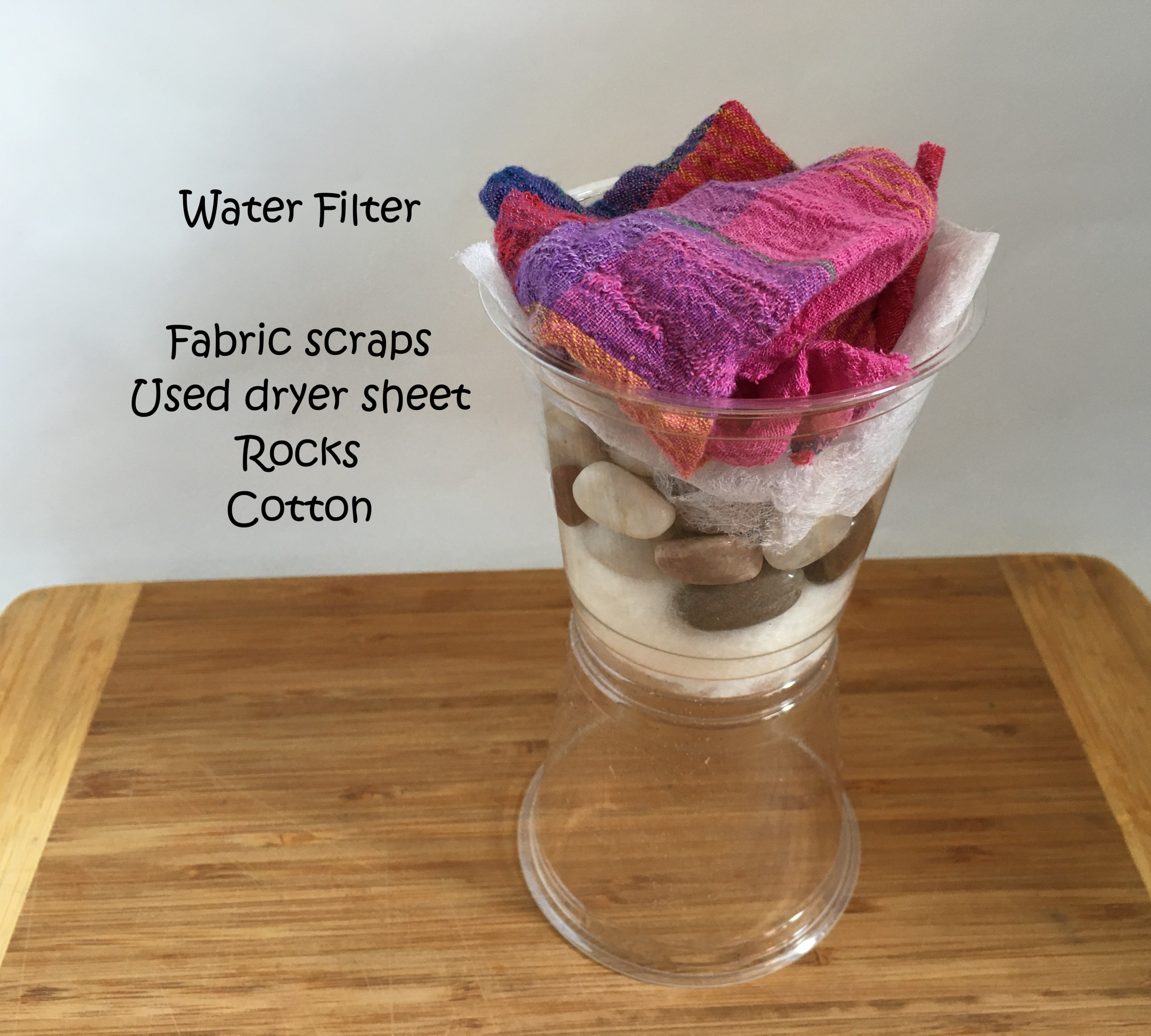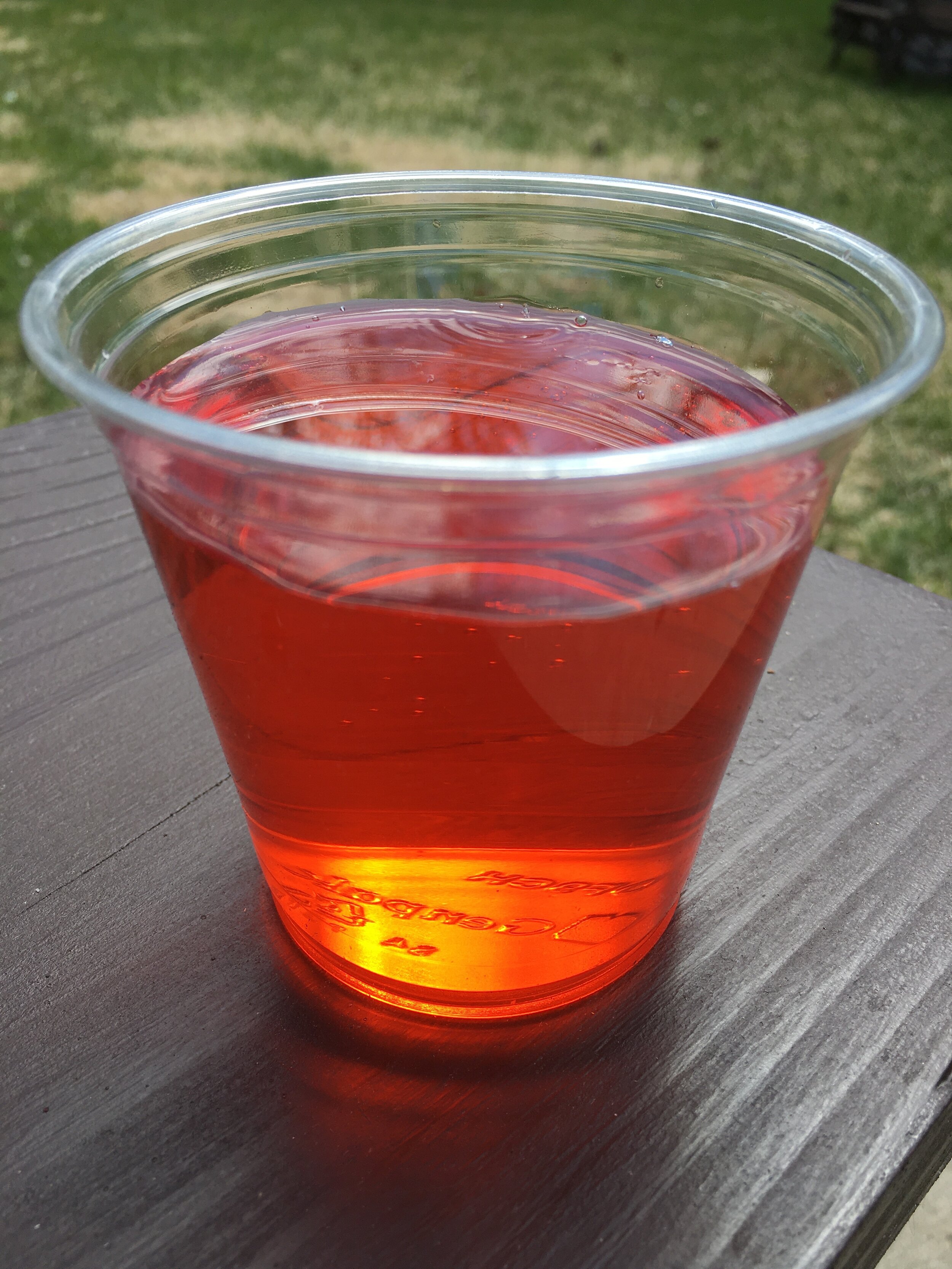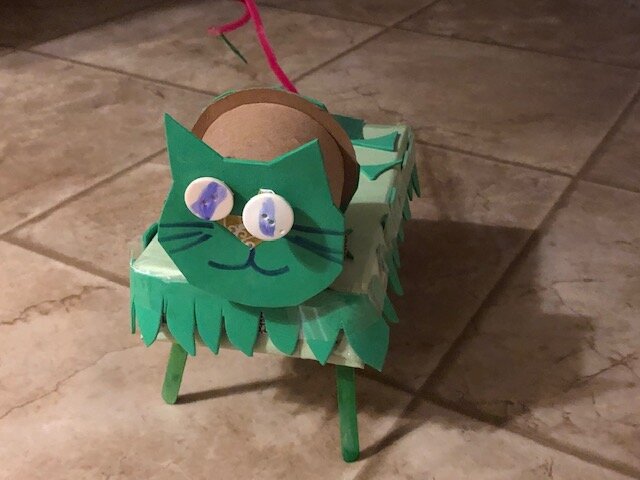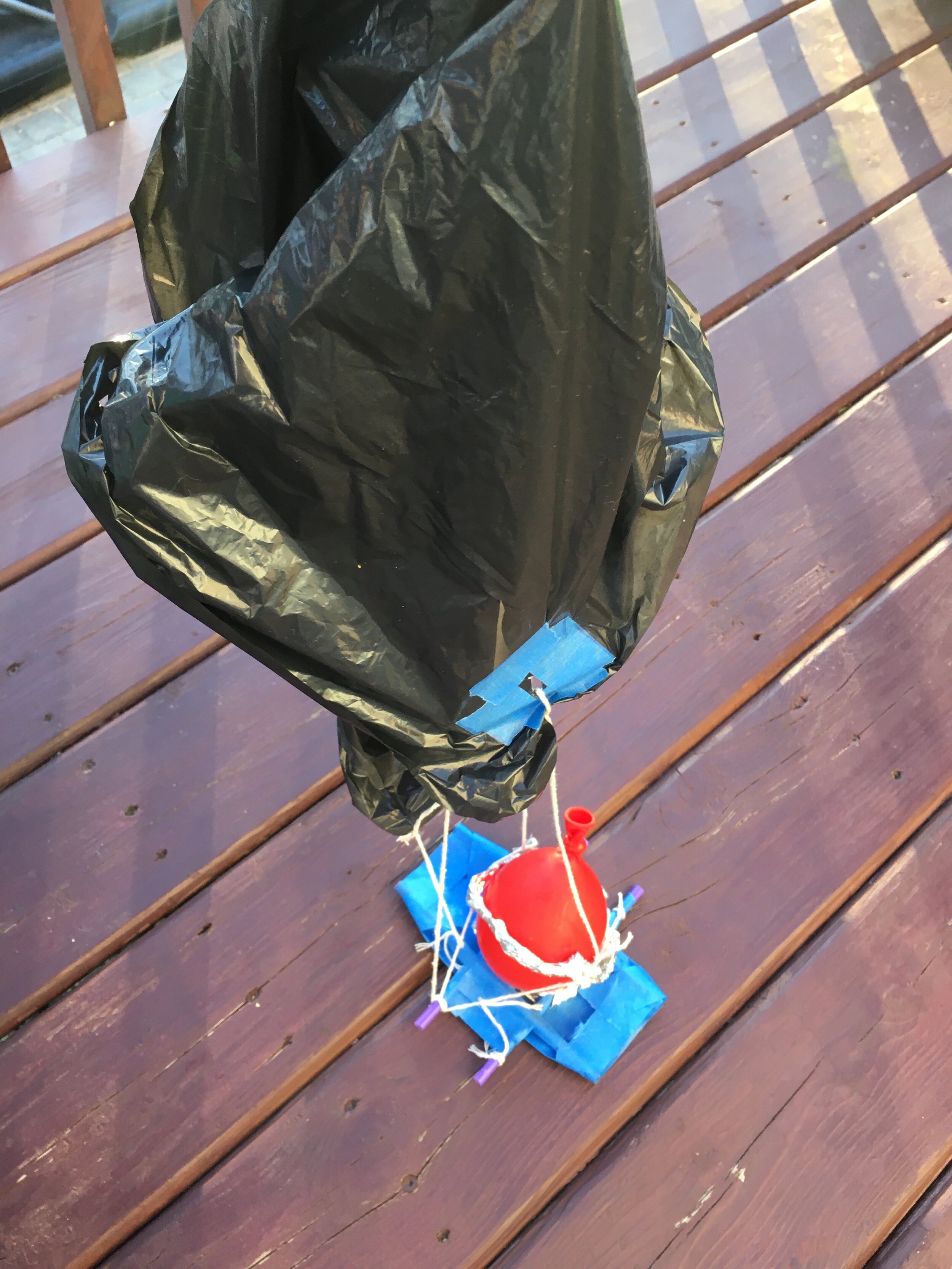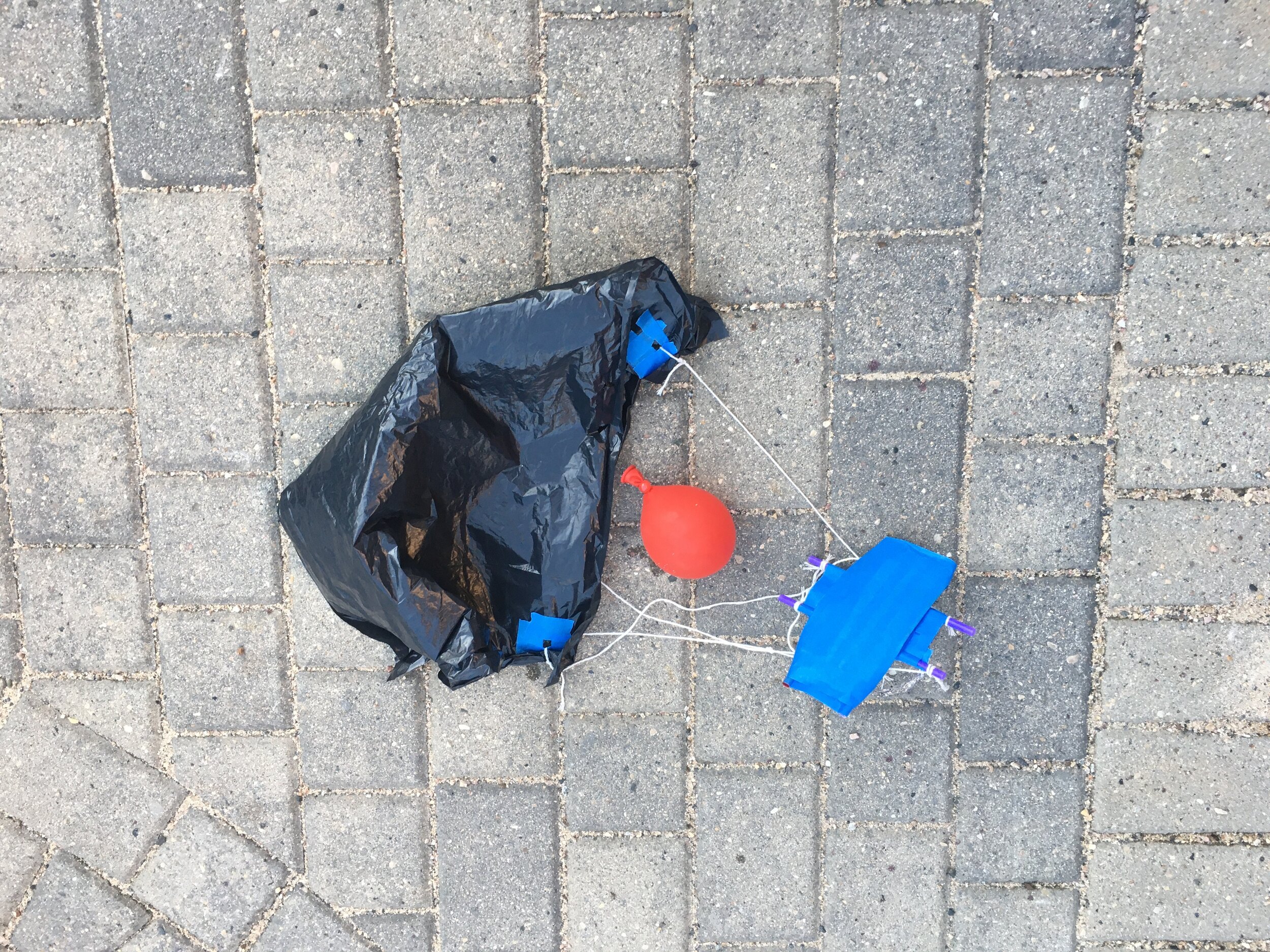
The Saskatchewan Science Centre Online! Check out our hilarious and educational web series “SSCTV”, find downloadable resources, explore other cool science links, and tune into the live BUBOCam!
Water Filter Challenge
The wilderness doesn’t have the luxury of tap or bottled water. Find out what needs to happen to make water from a creek to become safe to drink.
Activity Type
Challenge
Description
The wilderness doesn’t have the luxury of tap or bottled water. Find out what needs to happen to filter water from a creek to become safe to drink.
What you need:
2 clear plastic cups
Scissors
Pail, jar, jug or container to hold water
Water
Supplies to make the water dirty such as food colouring, glitter, small rocks, cooking oil, or small pieces of paper
Supplies to make dirty water
Supplies for building the filter. You do not need all the supplies listed here. Find supplies you think would make a good filter. Examples may include:
paper towels
gravel
sand
rocks
coffee filters
cotton balls
wool or yarn
scrap fabric or fibers
Supplies for building the filter
What you do:
1. Make some dirty water. Since we are only building test filters, you need to start by making some water you can use to test your filter.
• In a pail, jug or jar, add water.
• To that pail of water add something to make it dirty such as food colouring, glitter, small rocks, cooking oil or small pieces of paper.
• Mix together
Consider this:
What are some things that might make water dirty? Can all things be filtered out of water?
The dirty water we created - don’t drink it!
2. Make the water filter:
Can you make a filter that will clean the dirty water you just made?
• Cut one small hole in the bottom of one of the cups. That will be the cup where you build your water filter.
• Choose up to 3 or 4 materials to create the filter. You want to be able to filter out everything from the water to make it clean.
• You may want to try making your filter using supplies such as cotton balls, sand and yarn. Layer each material separately in the cup with the hole in the bottom.
Our completed filter
Consider this:
Does it matter in what order that the materials are stacked?
Will the filter materials make the water dirty?
Will everything you put into the water get removed from the water by the filter?
3. Test the water filter:
• Pour the dirty water through the test filter you just made. Be sure to have the other clear plastic cup under it to catch the water.
What does the filtered water look like?
Does it look clean?
Are any of the “dirty” particles left in the water?
What about the food colouring?
Do you think there might be things in the water you cannot see?
Filtered water
4. Inspect the filter
• Take the filter apart and look at the different layers.
o Can you determine which layer filtered some of the participles?
o Can you tell what each material removed from the water?
o How can you modify your filter to improve it?
Inspecting our filter
Parent tips:
• Explore the uses of water filters in the real-world settings. Encourage further exploration into the topic of wilderness survival. As well as the importance of available fresh water.
• Encourage curiosity and messiness. Try making water filters outside to avoid indoor messes.
• Allow for retesting and trying again. Find other materials to test, explore, and investigate.
Explanation:
Water is made up of very small particles called molecules. Each water molecule is made of two hydrogen atoms and one oxygen atom. That's why water is called H2O. When water is first poured into the filter, some of the water molecules stick to the gravel, sand, and cotton, making them wet. Once the filter is wet, the rest of the water molecules slip through the spaces in between the gravel, sand, and cotton. The dirt particles are bigger than the water molecules, so they can't get through. They get stuck in the filter.
Safe drinking water is important for survival. Water from lakes and rivers often has contaminants that make it unfit for drinking. The water may contain dirt, rocks and other objects that can be easily identified. There may also be unseen contaminants like bacteria, viruses, water born parasites, or organic matter dissolved in the water. For these reasons, water that is delivered to our homes must go through a water treatment process. This is typically a five-part process that consists of aeration, coagulation, sedimentation, filtration and disinfection. This activity is only concerned with filtration, which removes most but not all of the impurities from the water.
You most likely will be able to filter out most of the larger visible particles, but the food colouring will remain. This represents the bacteria, viruses, and chemicals that can be in water that are too small for the human eye to see and must be filtered out with ultrafine materials or chemicals.
Be sure to remember that we are only making a test filter and water found outside in puddles, lake and rivers might be unsafe to drink, even when using your filter.
Notes:
Saskatchewan Water Security Agency
Loving this content? Make a donation to the Saskatchewan Science Centre!
#waterfilters #cleanwater #letssciencethis #SaskScienceCentre #AtHomeWithCASC #ScienceChampions #ScienceAtHome #realsciencerealfun
Create A Creature Activity
In this activity, you will create a new species of animal, describing its habitat, and the characteristic that make it unique.
Create A Creature
There are millions of animal species in the world and scientists are still discovering new ones. The characteristics of an animal reflect the habitat they live in. In this activity, you will create a new species of animal, describing its habitat, and the characteristic that make it unique.
What would you name this creature?
Activity Type
Hands on learning
Age
5 to 10 years old
What You Need
Create a Creature worksheet (download here)
Tools: scissors, markers, glue, tape
Craft supplies; pipe cleaners, straws, paper, googly eyes, pom pom balls, string, buttons, string, fabric and recycled cups, containers, and cardboard.
What You Do
1 - Think about an animal that you know. All animals have unique traits and characteristics that allow them to survive in their habitat.
What are the important features of its habitat? All living things need certain things to survive; food, air, water, and shelter.
When something changes in an animal’s habitat that an animal and they are not able to get the things they need to survive, they will need to make changes. Over time, some animals develop adaptations or changes that will help it to survive. This new helpful trait is passed on to the next generation.
2 - Using the Create a Creature worksheet, create a new, still undiscovered animal!
What is your creature’s name?
What kind of animal is it? Invertebrate, fish, amphibian, reptile, bird, or mammal?
Where does your creature live? Does it live in water? On land? What makes this habitat a challenging place to survive in?
What kind of animal might try to eat your creature?
Who are its predators?
What does your creature eat? What is its prey? Does it eat plants only? Does it eat both meat and plants?
Does your creature have any special skills or abilities (adaptations) that help it survive in this habitat?
3 - Build your creature.
Using the craft supplies, make your creature into a 3D model. Using recycled materials is a great way to make the body.
4 - Describe it to someone else. Make sure to tell them about all the things that make it a new species and why it has the adaptations it does to survive.
Taking It Further
What adaptations would be needed for your creature if its food source ran out? Or if the habitat changed?
Think of your favorite animal. What makes it unique? What habitat does it thrive in and what habitat would it not survive well in?
Turn this activity into a game. Create cards that would describe an animal's habitat, special features, and characteristics. Build an animal by selecting a card from each category. What would an animal look like that has wings, lives in water, and eats plants look like?
Toothpick Towers
Build the tallest tower that can withstand an earthquake and learn how engineers use the strength of different shapes to design structures that can withstand the demanding elements.
Build Toothpick Towers
Build the tallest tower that can withstand an earthquake and learn how engineers use the strength of different shapes to design structures that can withstand the demanding elements.
What you need:
Toothpicks (be careful, the ends of toothpicks can be quite sharp).
Something for your toothpicks to stick into and help hold your tower together – mini marshmallows, gum drops, plasticine or modelling clay, or Styrofoam balls all work.
Flat table or surface to build your tower on.
Supplies for Toothpick Tower
What you do:
Make shapes by inserting your toothpicks into your Styrofoam balls, marshmallows, gum drops or clay. Whatever you choose to stick your toothpicks into will be the corners of your shapes. Make a two-dimensional triangle using three toothpicks and three corners, and a two-dimensional square using four toothpicks, and four corners.
Triangle
Square
2. Test the strength of your shapes. Press down on your square. What happens? Does the shape still hold together or does is bend and twist? Do the same for your triangle. What happens? Which shape do you think is stronger? What shape do you think would be best to use to build a strong tower?
Test the Triangle
Test the Square
3.A cube is a three-dimensional shape that has six sides, like a game die. Build your square into a cube by adding a vertical toothpick to each corner, and then complete the remaining squares on each side of your cube.
4.Test the strength of your cube by pressing down on it like we did before. What happens? Is the shape stronger now? Does it hold its shape, or does it bend and twist?
Cube
5. A tetrahedron is a three-dimensional triangle that has four sides. Build your triangle into a tetrahedron by adding a vertical toothpick into each corner, and then gather the three points of the toothpicks together in the centre and add the final corner.
6.Test the strength of your tetrahedron by pressing down on it like we did before. What happens? Is the shape stronger now?
Tetrahedron
7. What other shapes could you build and test to see which is the strongest? See the shapes below for some other shapes to try.
Now that we have an idea what shapes are strongest, we must design our tower. You can either draw your design, or just start building your idea to see what works and what does not.
For this challenge, design and build a tower that can:
Be a freestanding structure – meaning it can stand on its own without you holding it up or sticking it to the flat surface you are working on.
Try and only use 25 toothpicks.
Build it as tall as you can.
If something you design does not work, try again with a new idea. Don’t give up! Science is all about trying out new ideas and asking questions.
Tower Made With Cubes
Tower Made With Tetrahedrons
Explanation
An engineer is a person who designs and builds complex products, machines, systems, or structures. Engineers want to know how and why things work. They have scientific training that they use to make practical things. (National Geographic).
Structural engineers must consider many factors when designing a structure such as what is the purpose of the structure, where is it going to be, what kind of ground will it be built on, what kind of weather will it be faced with, what materials will be best to use and many other considerations.
Throughout this challenge, you participated in a similar engineering design process.
Engineering Design Process
What is a freestanding structure?
Freestanding means that it doesn’t need another structure to support it. Most houses are freestanding structures. The tallest freestanding structure in Canada is the CN Tower in Toronto. It was completed in 1976 and is 553.3 metres high. The tallest freestanding structure in the world is the Burj Khalifa completed in 2009. It is 829.9meters high located in Dubai, United Arab Emirates.
CN Tower, Toronto, Canada
Burj Khalifa, Dubai, UAE
Important terms:
Buckling: When a material bends under compression.
Compression: When a force pushes materials together.
Elasticity: The property of a material to bend or deflect, and then return to its original shape.
Force: Any influence that tends to accelerate an object; a push or a pull.
Load: The weight which a building or structure must carry.
Dead Load: The weight of the building itself plus all permanent fixtures; it does not change.
Live Load: Weight of the objects which move in, out, or shift in the building (people, furniture, etc.); it is constantly changing.
Plasticity: The property of a material in which it does not return to its original form after a bend or deflection.
Shear: When a force slides material against one another.
Tension: When a force pulls materials apart.
Taking it further
Once you have a tower design that is free standing you can measure how tall it is.
Gently shake the flat surface you are working on to simulate an earthquake or a windstorm. Does your tower still stand? What can make it stronger?
What can you place on top of your tower to test its strength? A book? A soup can?
How sturdy and tall can you make your tower using 50 toothpicks, or 100?
Keep designing and trying new towers.
What other structures can you build?
What would you need to consider if you were to build a bridge?
Loving this content? Make a donation to the Saskatchewan Science Centre!
#letssciencethis #SaskScienceCentre #AtHomeWithCASC #ScienceChampions #ScienceAtHome #realsciencerealfun
Pasta Bridges
Building a bridge that can withstand the elements requires some creative thinking, careful planning, and testing. Design and build the strongest bridge you can with uncooked pasta.
Build Pasta Bridges
Building a bridge that can withstand the elements requires some creative thinking, careful planning, and testing. Design and build the strongest bridge you can with uncooked pasta.
What you need:
Two pie plates turned upside down. These will act as the gap your bridge will try to cross. Any two items of the same height will also work
Uncooked spaghetti - as much as you need (depends upon how long you want your bridge to be!)
Plasticine or modelling clay
Hot glue gun (Have an adult help you with this!)
Elastic bands
Ruler
Tape
Weights or toy cars to test the strength of your bridge
Several pieces of paper
Something to write with
What you do:
A bridge is a structure that crosses over an open area, such as a river or mountain valley. Before we build our pasta bridge, let’s test some basic ideas.
Place your items that are the same height on a flat surface and measure the distance between them. A suggested distance is about 30 cm. If you are using pie plates, be sure to place them on the surface so the bottom is facing up.
Cut a strip of paper about 7 cm across, and a bit longer than the distance you measured between your two items.
Place the strip of paper on top of the two items. Place your toy car on the paper to test to see if your simple paper bridge can hold the weight of the toy. What happens? Most likely, your strip of paper was not strong enough to hold the weight of the toy car and your toy car fell. What can we do to make this bridge stronger?
Engineers create strong bridges by combining different types of structures together such as beams, arches, trusses and suspensions. In the explanation section below, there are some examples of each type of these structures. We are going to test three of these structure types in paper first before we get to work building our pasta bridge.
Using some paper and a pen or pencil make a simple chart like the one below:
| Bridge Structure | What Happened? |
| --------------------- | --------------------- |
| Beam | |
| Arch | |
| Truss | |
| Combination |
For beams, try making a paper tube the same height as your pie plates and place it the middle of the distance between the pie plates. Now, place that strip of paper we did the first test with on top of the beams. Test your beam bridge with your toy car. What happens? Record what happens in the chart you made. What happens if you use two beams, or three? Test and record your results in the chart.
To test an arch, take another strip of paper about the same size as the first one and try to curve it into a half circle. You could also use a paper cup on its side. Place your paper arch between the pie plates, and your first strip of paper on top of your arch. What happens? Record what happens in the chart you made. What if you used multiple smaller arches? Test and record your results in the chart.
To test trusses, take another piece of paper and fold down the top about 3 cm down. Turn the paper over and fold down again another 3cm. Repeat folding back and forth until you have folded your way to the end of the paper. You should have something that looks like this:
Put your folded piece of paper in between the pie plates, and your test strip of paper on top of the folded paper. What happens? Record your results in your chart.
Now try some combinations of these structures. Test an arch with trusses, or an arch of beams. Keep testing your car on each combination you come up with and record your results in the chart.
Now that we know a little about what makes a bridge strong, let’s design our pasta bridge. Draw out your design on a piece of paper. Don’t forget to include what we have learned so far about the different types of structures engineers use in their bridge designs.
Build your pasta bridge design. You can use a hot glue gun if there is an adult around to help you, or you can use elastic bands, tape, or modelling clay to construct your pasta bridge.
Once complete, don’t forget to test the strength of your bridge and record your results. How can you change your design to make your bridge even stronger?
Explanation:
Bridges have been built for thousands of years using a range of different materials such as rocks, mud, lumber, metal, concrete, and even glass. The strength of a bridge is determined by its structure, not the materials it is made of.
Engineers create strong bridges by combining different types of structures together such as beams, arches, trusses and suspensions.
Here are some examples of different structures engineers use when designing their bridges:
BEAMS
Beam bridges use pillars dug deep into the ground or foundation to support the weight of the bridge on top of the pillars.
ARCHES
Arch bridges use an arch underneath the pathway to support the weight of the bridge, and also allows people and vehicles to pass under the bridge.
TRUSSES
Truss bridges use multiple triangles and walls to give a bridge strength.
SUSPENSIONS
Suspension bridges use cables between the deck of the bridge and towers along the bridge to help hold the weight of the bridge.
An engineer is a person who designs and builds complex products, machines, systems, or structures. Engineers want to know how and why things work. They have scientific training that they use to make practical things. (National Geographic).
Structural engineers must consider many factors when designing a structure such as what is the purpose of the structure, where is it going to be, what kind of ground will it be built on, what kind of weather will it be faced with, what materials will be best to use and many other considerations.
Throughout this challenge, you participated in a similar engineering design process.
Important terms:
Buckling: When a material bends under compression.
Compression: When a force pushes materials together.
Elasticity: The property of a material to bend or deflect, and then return to its original shape.
Force: Any influence that tends to accelerate an object; a push or a pull.
Load: The weight which a building or structure must carry.
Dead Load: The weight of the building itself plus all permanent fixtures; does not change.
Live Load: Weight of the objects which move in, out, or shift in the building (people, furniture, etc.); constantly changing.
Plasticity: The property of a material in which it does not return to its original form after a bend or deflection.
Shear: When a force slides material against one another.
Tension: When a force pulls materials apart.
Taking it further:
Try building a bridge out of paper and tape and see if your bridge can hold the weight of 100 pennies.
Try testing how suspension structures work.
Take a walk around your neighbourhood and see if you find any bridges. Draw the different structures that you see that make the bridge strong.
How much weight can your bridge hold?
What is the longest bridge you could build?
Can your bridge survive a windstorm or an earthquake? How could you test that?
Try building a cantilever bridge as shown below.
Loving this content? Make a donation to the Saskatchewan Science Centre!
#letssciencethis #SaskScienceCentre #AtHomeWithCASC #ScienceChampions #ScienceAtHome #realsciencerealfun
Mission Parachute Drop
A summertime twist on the classic egg drop engineering challenge. Instead of protecting an egg with a parachute you design and create one that will prevent a water balloon from bursting when dropped to the ground using only the supplies listed.
Mission Parachute Drop
Here is a summertime twist on the classic egg drop engineering challenge. Instead of protecting an egg with a parachute you design and create one that will prevent a water balloon from bursting when dropped to the ground using only the supplies listed.
What you need:
1 piece of paper (tissue paper or newspaper)
String (no more than 100 cm)
6 straws or wooden popsicle sticks
25 toothpicks
Plastic garbage bag
Aluminum foil (1 piece)
Masking tape
Small balloon
Water
Scissors
What you do:
Research images of parachutes. How to they look when falling? What makes them expand? What forces are utilized when the parachute drops? How can a person or object be protected as they land?
Your challenge is to make a parachute with the water balloon as cargo. You will need to make your parachute land slowly and fall to the ground safely.
Gather materials: use only the materials listed to make it more challenging. From the images you saw and the supplies available sketch out the design of the parachute.
Cut a large piece from the plastic garbage bag. Make your own design, either round, square or octagon. This is the canopy.
Cut small holes around the edges of the canopy so the string can be attached. Secure the holes with a bit of tape.
Attached the string to each hole. Add more tape to make sure that the string will not pull through the plastic.
Create a basket or holder for the water balloon from the straws, popsicle sticks, and toothpicks. Cover any sharp edges with aluminum foil, plastic and tape. Make sure the balloon can fit safely and securely.
Fill the balloon with water keeping it small enough to fit safely into the basket you created.
Test your parachute: Find an outdoor location in which you can stand on a surface that elevates you about one metre from the ground. Places such as the top of a deck, the ladder of a slide, or from a picnic table. Be sure to ask an adult for help with climbing. Make sure that the water balloon is secure and safe in the basket. Count down and release the balloon and parachute.
Observe the results. Was your parachute built to safely land the water balloon on the ground? What things would you change? If the parachute was dropped from an airplane, would it survive the drop? Make changes and modification to the parachute and try it again!
How it works:
Everything including air is made of matter. You may not always feel it, but air is always pushing on you. Think about a time you rode your bike fast or had a window open when the car was moving, did you feel the air on you? This is called air resistance or drag. Drag is the force that is felt when a solid object moves through air. When designing a parachute, you want there to be a lot of drag on the object that is falling so that it slows down, reducing its speed and making it land soft.
The design of a parachute is important. Most parachutes are round, and dome shaped but some are made rectangular. The rectangular parachutes have many cells for air to get caught in and slow the object as it falls.
Taking it further:
Test the gravitational force: try dropping two objects that weigh different amounts, such as a rock and a feather, to the ground and observe how they fall. Galileo conducted this experiment a long time ago, by dropping a feather and a rock from a tower. He wanted to know if the weight of an object affects how fast it will fall. When you did this experiment did you notice that the rock landed first. It was not because it was heavier but because of its shape. Just like a parachute a feather shape causes it to float down using as much drag as possible in landing.
Loving this content? Make a donation to the Saskatchewan Science Centre!
#letssciencethis #SaskScienceCentre #AtHomeWithCASC #ScienceChampions #ScienceAtHome #realsciencerealfun





